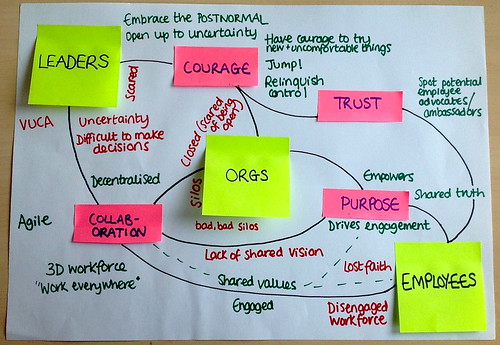The Value of Internal Communities for Business

Image source:
dilbert.com
I like unpredictability in general, but sometimes routines work for me. I wake up every morning at the same time, I drink a glass of water (it’s supposed to be good for your metabolism to get your digestive system going before eating real food), I go to the gym, I get ready, I have a healthy breakfast, and off to work I go.
When I get to work I hook up my laptop, grab a cup of coffee and read my daily Dilbert cartoon on a calendar that someone gave me for Christmas. In today's cartoon, Wally was talking about a social network project and his colleague responds:
“That sounds like something that no one wants and no one needs.”
The Value of Social Networks
I disagree. I love your humor, Dilbert, but this time you’re wrong.
OK, it’s just a cartoon and the comments
made in there don’t have to be 100% accurate, but I wanted to bring attention to
the fact that the phrase "social network" is everywhere.

Photo source:
flickr.
So, why are we seeing the phrase SOCIAL
NETWORK being used everywhere? Why are people interested in friending each
other on Facebook? Why do people follow
DNN Corp on Twitter? The answer is, because
we are social,
we like to connect with other people and share our ideas and
experiences. The only new thing is that we are taking our social skills to the
web, which has virtually unlimited scale. We’re just seeing what used to be
confined to face to face interactions being exposed to a much larger audience
using the Internet.
Social Networks are huge and they’re changing the way
we live our lives.
This begs the question, is
this going to change the way we work?
Hell yes!
Being Social via Internal Communities
We recently
deployed a new intranet named Catalyst. The new intranet gives us a very nice Facebook-like activity stream, a place to share ideas,
a place to ask questions, blogs, and more.
For the last few months, we have been
engaging with each other, generating trust, sharing ideas, collaborating,
sharing knowledge, and making jokes (amongst many other things).
We have
been extracting the value of our relationships.
Here are three of my recent experiences in Catalyst.
Generating Trust

Photo source: Laura Dinneen on
flickr.
We're a global company. At the beginning of this month, I had meetings scheduled at our headquarters office in Northern California (I'm based in our British Columbia office in Canada).When I walked into headquarters on Monday morning,
I heard a voice yelling, “
Israel, you’re here!”
I turned around, it was Megan,
one of our new additions, who is based at headquarters. I had never seen her or spoken
with Megan before, we had only interacted in Catalyst. The flow of our
conversation, however, was as if we had known each other for a long time.
We generated trust.
Side note: Read Megan's blog post, "
Helping a Family During the 2013 Holiday Season."
Shared Knowledge
Our marketing team produces a
lot of great content, but it is not possible for them to create
documents that answer every possible question a prospect may have. A prospect called asking about
the potential integration of our software with SharePoint Online for Office 365
and Barbara entered the question in Catalyst. I have worked with SharePoint
before and I had the opportunity to answer her question.
I shared knowledge.
Sharing Ideas
We’re constantly hiring, so it’s hard to keep
track of everyone’s location and function. When we deployed Catalyst, Joe
suggested we create an employee map that included time zones, so we all know
where everyone is (along with their local timezone) in case we need to make a call or schedule a
meeting with someone.
Joe shared an idea.
Conclusion
For hundreds of years,
organizations have been improving the old command and control model based on a
highly controlled communication flow, but it has
probably gone as far as it can
go. In the next few years, we’re going to be adapting a new model where
communication, collaboration and cooperation are more fluid. We’re going to
extract the value of trust, reciprocity and teamwork.
So, this is why you’re wrong, Dilbert.
Because if you don’t socially network,
you’ll miss the value of the give and
take
between you and the rest of your organization.